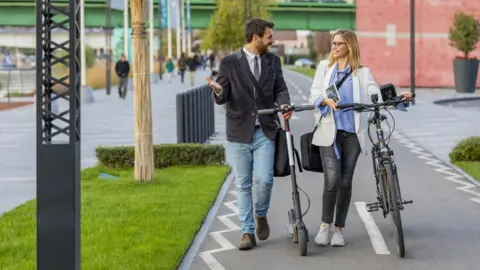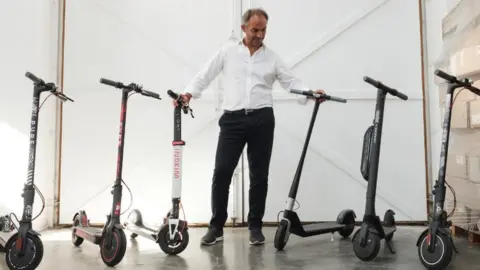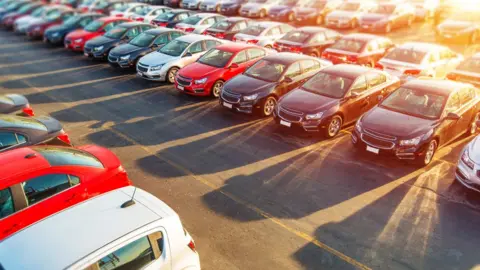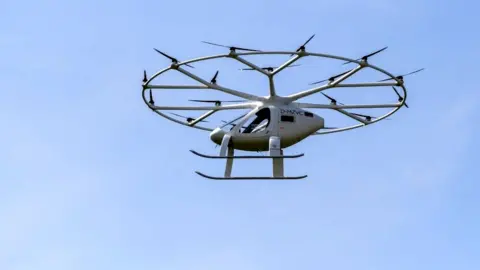Coronavirus: How will you commute to work after lockdown?
 Getty Images
Getty ImagesThe traditional commute may never be the same again once people return to work after lockdown in what is likely to be an era of social distancing.
It's a particularly big problem for workers in the UK's largest cities.
One recent report warned that maintaining a 2m (6ft 6in) distance between Tube passengers in London, for example, would reduce its capacity to 15% of normal levels, and buses to 12%.
But if more people take to the streets, will the road network cope?
"If in big cities we are to have a radical shift to bicycles, scooters, other ways of getting about, that would require a sudden and radical change in road use," said Prof Tony Travers from the London School of Economics.
"You have to move people quickly through streets and the easiest place to do that is main roads. But they are used by buses, taxis, delivery vehicles and other essential vehicles. Changing road use doesn't happen quickly."
The use of public transport would also need to be staggered, with "rush hour peaks" lasting perhaps for five-hour stretches, and spaces being allocated, Prof Travers suggested.
Previous experience suggests this would not be an easy change to bring about.
"Public transport operators have spent decades trying to get users to spread the rush hour," he said.
"It would be hard to do this voluntarily. You would have to have some degree of people, in effect, being allocated slots."
It would also have knock-on consequences for other aspects of daily life.
"Will cafes, bars and restaurants need relaxed licensing laws so they can be open for longer? How about parents with children who need to collect them from school?" he said.
"It has profound implications for how businesses work."
So - what is the best alternative?
Electric scooters
They're largely banned on UK public roads and pavements, but e-scooter sales have doubled year-on-year for Somerset-based retailer Pure Electric.
It sold 135 e-scooters in a single day last week, and 11,500 last year.
"Electrification is coming - it's a low cost, low impact transport," says chief executive Adam Norris. His firm also sells e-bikes.
Mr Norris's UK-wide best-selling e-scooter is the M365 from Chinese budget brand Xiaomi.
They have a speed cap of 15km/h (10mph) and he suggests they're ideal for journeys of around two to four miles, with e-bikes taking a slightly longer haul.
E-scooters are a common sight in many cities around the world including Paris and LA but officially in the UK they are only allowed on private land.
 Pure Electric
Pure ElectricThe government was planning a public consultation prior to the pandemic but campaigners have long warned of the dangers to both pedestrians and riders.
In 2019 TV presenter Emily Hartridge, 35, was riding an electric scooter when she was killed in a collision with a lorry in south London.
However, Mr Norris thinks a change in the law is "logical" following the rise in consumer demand, and he believes that with sensible precautions such as high-vis clothing and newer models with larger wheels to tackle potholes, safety can be improved.
"Safety is important," he said. "But if they limit all e-scooters to the same speed as electric bikes, what's the difference?"
Analyst Carolina Milanesi, from Creative Futures, thinks even with the right legislation in place, people may be less likely to want to hire electric vehicles, a service offered by firms like Lime and Bird.
"I am not sure if e-bikes and scooters are necessarily the way people will go unless they invest in them themselves, rather than using hire services which would require them to clean them when they get them," she said.
Take your own car
Anthony Eskinazi runs the platform Just Park, which lets people offer their parking spaces up for rent. He says the firm is considering turning its own 300 car parks into storage for scooters and bikes.
 Getty Images
Getty ImagesHe believes "the balance between congestion and convenience" may mean car owners won't want to use individual vehicles for very long once traffic builds up.
"I think parking demand will surge after lockdown but it won't be sustainable," he said.
"People want a real alternative now. If the government can facilitate it we will see a boom in micro-mobility."
Get a cab
By its own admission, lockdown has proved to be a challenging time for Uber, which says it is now "preparing for the next phase of recovery".
 Getty Images
Getty ImagesIt is supplying PPE gloves and masks to all its drivers and is considering calls to pay them a small fee if they take time out between passengers to clean their vehicle interiors.
"I do wonder what the impact on Lyft and Uber will be," said Carolina Milanesi.
"What will these companies have to disclose to grow trust that the driver or the passenger is safe?"
Uber might adapt a newly launched driver ID tool to ask drivers to upload selfies to prove they are wearing masks at work, it said.
The firm is also developing its own driverless car - but it was only allowed back on the roads in California two months ago following a fatal crash in 2018.
Drone taxis
If all else fails, how about a flying taxi?
 Getty Images
Getty ImagesYou might have problems hailing one. There are 175 drone taxi designs floating around (sorry) but as yet no regular service in any one country.
"I have been watching empty buses drive past for the last few weeks, and every time I think of how great it would be to provide small-scale public transport with robot taxis," says Dr Steve Wright, associate professor in aerospace engineering at the University of the West of England.
"I really want these taxis to be flying ones too, but I think I am going to have to wait, as the coronavirus is probably going to hinder the Evtol [vertical take off and landing] revolution more than encourage it.
"The meltdown going on in the airlines is probably going to drag down the whole aviation industry."
